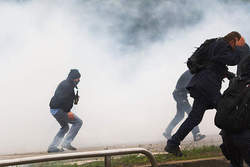Scared of terrorists, and the sun
This coming July 7, Japan will host a three-day Summit of G8 nations at Lake Toya, within the scenic confines of Shikotsu-Toya National Park in southern Hokkaido. What better time, asks Shukan Taishu (Feb. 18), for al-Qaida terrorists to launch a strike against Japan? Of course terrorism won't be the sole security problem.
"The meeting's isolated venue will make it easier for police to keep watch, but extreme radical groups are constantly mobilizing, and I can foresee foreign agitators going on rampages," predicts Buntaro Kuroi, editor of the military affairs magazine World Intelligence. He points out that at the June 2008 G8 summit in Heiligendamm, Germany, about 1,000 demonstrators were arrested.
To augment the 20,000 police, Shukan Taishu notes other measures are being mulled, including a Self Defense Forces battery of PAC3 ground-to-air missiles to guard against a 9/11-style air attack.

More worrisome than the safety of VIPs, however, is the possibility of terrorists' going after "soft" targets of opportunity.
"During the summit's coverage by the worldwide media, there's a possibility major cities like Sapporo, Tokyo, Nagoya or Osaka could be targeted," suggests Motoaki Kamiura, a military-affairs expert, who notes that during the G8 summit in Gleneagles, Scotland, in July 2005, terrorists set off bombs in London, killing 52 people and injuring over 700.
A bomb using bottled propane gas, which could be set off in the subway, can be constructed using materials bought in local shops.
"Any chemist who knows his stuff can use ingredients available at drug stores to produce explosives that have 70 to 80 percent of the destructive power of military devices," Kamiura adds.
"Terrorists could just steal a gasoline tanker and crash it into a shopping mall, or hijack an oil supertanker and ram the U.S. Naval facility at Yokosuka," he continues. "If al-Qaida makes a serious effort, hundreds could be killed. At the very least we have to be on guard against these kinds of things."
Scary sunspots
Even if Japan makes it through 2008 unscathed, Mother Nature may still wreak havoc a few years from now, as the U.S. National Oceanic and Atmospheric Administration has predicted the sun's cycle of intense activity will reach its peak toward the end of 2011.
Weekly Playboy (Feb. 18) reports that a pair of huge storms, measuring five to six times the diameter of the entire Earth, have been observed on the surface. Each solar flare, according to space maven Nobuo Nakatomi, emits energy equivalent to 100 nuclear reactors, bombarding the Earth with a blizzard of charged electrons that can affect everything from civil aviation to passenger cars and even cell phones.
If severe enough, this high-tech nation might very well go into a tailspin.
Interference with GPS (global positioning system) signals beamed from satellites can throw off the accuracy of auto-navigation units by tens of meters. Another serious concern is aviation safety, as solar flares have been known to affect communications between airport control towers and civil aviation.
Then there's those cell phones. The relay stations that transfer signals between cell-phone handsets are linked by cable, but the network is still highly vulnerable and if severe disruptions occur, cell-phone communications will be knocked out for the duration.
Terrorists may be scary, but the prospect of 100 million Japanese simultaneously denied use of their cell phones is truly horrifying to contemplate.
By MARK SCHREIBER
[http://search.japantimes.co.jp/cgi-bin/fd20080210t3.html]
Source: www.japantimes.co.jp



